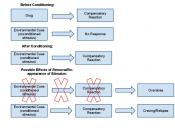Classical conditioning is type of associative learning that was demonstrated by Pavlov's experiments with dogs and their salivation. In his experiments, Pavlov conditioned the dogs to salivate at the sound of the bell, an unnatural reflex, even before the food is presented. At first the dogs did not salivate when the bell was presented until they learned to associate the sound of the bell to the presence of the food. Like the dogs in Pavlov's experiment, humans also learned by classical conditioning.
Here are two examples of classical conditioning from my own learning experiences. Ever since when I was a little girl, every time I get sick my mom would make me her homemade chicken noodle soup. For some strange reason I would feel better right away after I eat this soup. Since then my mom's soup has become my only remedy to get better. So whenever I get sick, even before my mom makes me her soup, I would feel better just at the sight of her presence in the room.
The neutral stimulus in this case is my mom, the unconditioned stimulus is the chicken noodle soup, and the unconditioned response is to feel better. After I have been conditioned, my mom has turned into the conditioned stimulus and seeing her would elicit the conditioned response of feeling better and no longer being sick. Another example of classical conditioning is how I came to dislike anything that looks like milk. I'm lactose intolerance but I can consume all other dairy products except for milk. Drinking milk would make my stomach hurts and cause me to throw up. This problem with milk has caused me to dislike anything that resembled the color of milk, such as: Alfredo sauce, soybean drink, horchata, and melted vanilla ice cream. Just looking at...


